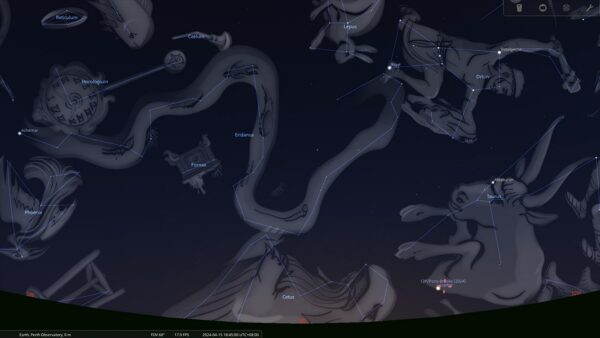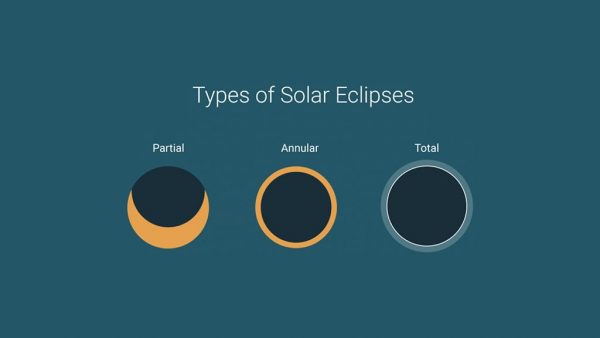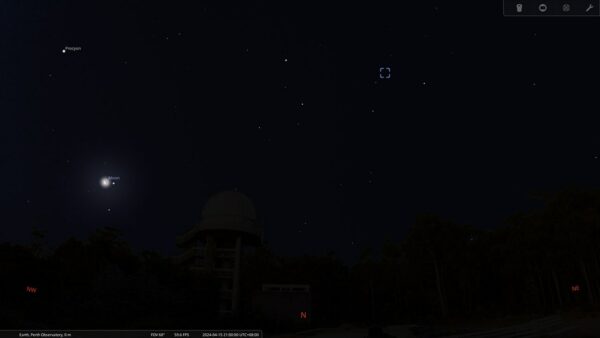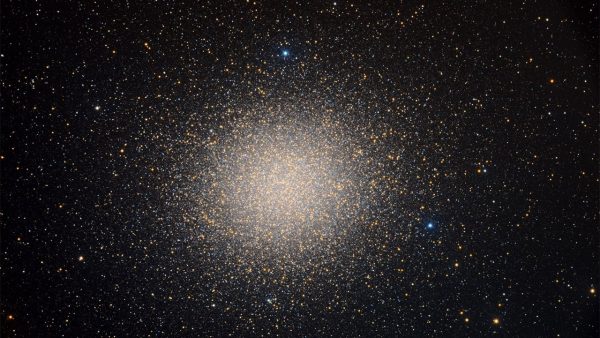Find out what to go out and look at this month
Planets:
In early April, Mercury remains concealed within the Sun’s brilliance, gradually emerging from its glare around the 20th, revealing itself in the eastern sky just before dawn. Positioned low between Aquarius (The Water-Bearer), Cetus (The Sea-Monster), and Pisces (The Fish), it becomes discernible shortly after sunset. Venus graces the early morning throughout April, its trajectory leading it from the constellations between Cetus and Pisces to a position within the Pisces constellation by month’s end, intersecting with Mercury on the 20th.
Mars, commencing its celestial journey within the constellation of Aquarius (The Water-Bearer), gradually traverses away from this constellation throughout April. Passing Saturn on the 11th, it proceeds between the constellations of Cetus and Pisces, eventually drawing close to Neptune by month’s end.
Jupiter, initially adorning the northwest sky within the constellation of Aries (The Ram), transitions into Taurus (The Bull) as April progresses, before succumbing to twilight’s embrace a few days before month-end. Saturn is in the east during the early morning hours, within the constellation of Aquarius. Uranus, gracing the evening sky within Taurus throughout April, it does mirror Jupiter’s fate, vanishing into twilight’s veil before month-end, leaving the evening bereft of planetary presence.
Lastly, Neptune unveils its splendour in the early morning hours, nestled amidst the constellations of Cetus and Pisces.

|

|
| Planet | When It Rises Or Sets |
|---|---|
| Mercury | At the start of April, it’s still in the Sun’s glare, and by the end of the month, it’ll rise at 04:56 am (AWST) |
| Venus | At the start of April, it rises at 07:55 pm (AWST), and by the end of the month, it’ll rise at 06:01 am (AWST) |
| Mars | At the start of April, it rises at 03:44 am (AWST), and by the end of the month, it’ll set at 03:35 am (AWST) |
| Jupiter | At the start of April, it sets at 07:55 pm (AWST), and by the end of the month, it’ll sets at 6:23 pm (AWST) |
| Saturn | At the start of April, it rises at 04:16 am (AWST), and by the end of the month, it’ll rise at 02:35 am (AWST) |
| Uranus | At the start of April, it sets at 08:04 pm (AWST), and by the end of the month, it’ll be in the Sun’s glare |
| Neptune | At the start of April, it rises at 05:23 am (AWST), and by the end of the month, it’ll rise at 03:33 am (AWST) |
Alignments, Conjunctions And Occultations:
Conjunctions are a phenomenon that involves objects within our Solar System, as well as more distant objects such as stars. From the observer’s perspective, it appears as though multiple objects that aren’t close together, in reality, appear close in the sky.
On the other hand, an occultation is an event that occurs when one celestial body passes across the line of sight between an observer and another celestial body. One example of an occultation is a solar eclipse, which occurs when the Moon passes in front of the Sun from the perspective of the observer.
- 06/04/24 – Conjunction of The Moon, Mars, and Saturn (Where to look)
- 07/04/24 – Alignnment of The Moon, Venus, Mars, and Saturn (Where to look)
- 11/04/24 – Conjunction of Mars, and Saturn (Where to look)
- 11/04/24 – Conjunction of The Moon, Jupiter, and Pleiades (Where to look)
- 15/04/24 – Conjunction of The Moon, Castor, and Pollux (Where to look)
- 18/04/24 – Conjunction of The Moon, and Regulus (Where to look)
- 20/04/24 – Conjunction of Mercury, and Venus (Where to look)
- 20/04/24 – Conjunction of Jupiter, and Uranus (Where to look)
- 23/04/24 – Conjunction of The Moon, and Spica (Where to look)
- 26/04/24 – Conjunction of The Moon, and Antares (Where to look)
- 29/04/24 – Conjunction of Mars, and Neptune (Where to look)
Astronomical Events This Month:
Comet 12P/Pons–Brooks:
12P/Pons–Brooks is currently gracing the early evening sky of the Northern Hemisphere until the 5th of April, after which it will become visible to the Southern Hemisphere low in the northwest. With a nucleus diameter of approximately 34 kilometres, akin to Mount Everest, this periodic comet completes an orbit every 71.3 years, last visiting the inner Solar System in 1954. It’s named after French astronomer Jean-Louis Pons, who discovered it in the early 19th century, and British-American astronomer William Robert Brooks, who observed it during its next orbit in 1883.
Expected to brighten to an apparent magnitude of 4.5, it will soon become visible to the naked eye. Its closest approach to the Sun (Perihelion), on April 21st, will see it shine its brightest, slightly beyond the orbit of Venus at 0.8 AU (116.8 million km), with a predicted magnitude of 4.1. On June 2nd, it will make its closest approach to Earth, at 232 million km.
This time around, the comet has displayed an intriguing change in appearance, sporting a distinctive horseshoe-shaped coma, reminiscent of the Millennium Falcon from Star Wars. Notably, it experienced outbursts on October 5th, 2023, and again in late November.
The orbit of Comet 12P/Pons–Brooks is highly inclined at 74.2°, reaching aphelion at 33.6 AU from the Sun, just beyond Neptune’s orbit. It is believed to be the progenitor of the weak December Draconids meteor shower, active from November 29th to December 13th. Among the brightest known periodic comets, it belongs to the Halley-type group, characterized by orbital periods of 20–200 years. Ancient records also suggest sightings of comets suspected to be apparitions of 12P/Pons–Brooks.

|

|

|

|
Total Solar Eclipse:
On April 8th, 2024, the Great North American Eclipse will occur. Unfortunately for us in Australia, the path of totality for this total solar eclipse runs through Mexico, the United States, and Canada. During totality, the Moon will fully obscure the Sun. During a Total Solar Eclipse, the Moon blocks out the full disc of the Sun, which enables astronomers to study the Sun’s Corona and Chromosphere. Both parts of the Sun are normally invisible due to the extreme brightness of the Sun’s surface.
Observers in Mexico in the path of totality will experience 4 minutes and 28 seconds of totality which with quite a bit more than the 59 seconds observers got to witness on the path of totality at Exmouth for the Ningaloo Total Solar Eclipse last April. During totality, the sky will become dark with stars and planets being visible, the air temperature will drops, and animals may change their behaviour. If you’re not heading to North America for the eclipse, our friends at Timeanddate.com will be live streaming the eclipse, I’ll be an expert on the Office Hours daily show’s live stream of the eclipse.
| Event | UTC Time | Time in Perth* |
|---|---|---|
| First location to see the partial eclipse begin | 8th of April at 15:42:15 pm | 8th of April at 11:42:15 pm |
| First location to see the full eclipse begin | 8th of April at 16:38:52 pm | 9th of April at 12:38:52 am |
| Maximum Eclipse | 8th of April at 18:17:21 pm | 9th of April at 02:17:21 am |
| Last location to see the full eclipse end | 8th of April at 19:55:35 pm | 9th of April at 03:55:35 am |
| Last location to see the partial eclipse end | 8th of April at 20:52:19 pm | 9th of April at 04:52:19 pm |

|

|

|

|
The Lyrids Meteor Shower:
On the night of April 22nd/23rd, while most of us are asleep, the Lyrids meteor shower will hit the Earth’s atmosphere at its peak. The Lyrids are the oldest observed meteor shower, with records of its observation dating back to at least 2,600 years ago in China. Described as “stars falling like rain” on the night of March 16th, 687 BC, the shower has become a minor one in recent times, with occasional surprises that keep it interesting.
The cause of the Lyrids is Comet C/1861 G1 (Thatcher), a long-period comet that orbits the Sun every 415 years. The comet was discovered by A.E. Thatcher on April 5th, 1861, during its last pass around the Sun. The Lyrids are active between April 16th and 25th and appear to come from the constellation Lyra.
To observe the Lyrids, look towards the constellation Lyra in the early morning hours when it’s at its zenith, the highest point in the sky. Lyra will appear over the Perth hills around midnight, and it’s best to wait until around 03:00 am (AWST) when the constellation is at its highest point and the sky is at its darkest. Allow your eyes to adjust to the darkness for at least 15 minutes. While it’s best to go to a dark sky area outside of Perth, you can still enjoy a decent view by finding a park or large open space in Perth’s outskirts.
Unfortunately, this year the Lyrids meteor shower will be competing with the Full Moon, so the meteor shower will be affected by the Moon’s light pollution. In a dark sky area, you should be able to see up to 5-10 meteors per hour.

|

|

|
Things To Look At This Month:
Leo Triplet:
The Leo Triplet, also known as the M66 Group, is a small cluster of galaxies located in the Leo constellation, situated approximately 35 million light-years away from Earth. This trio of galaxies comprises Messier 65 (NGC 3623), Messier 66 (NGC 3627), and the Hamburger Galaxy (NGC 3628). To observe the best views of this galaxy cluster, it’s recommended to venture out to the countryside with a telescope. To plan an astronomy trip, it’s worth checking out the Astrotourism WA Map.
Messier 65 is an intermediate spiral galaxy, slightly smaller than our Milky Way, with a diameter of 90,000 light-years. Although star formation is limited in this galaxy, there have been recent star-forming activities in its spiral arms. The ratio of old stars to new stars is significantly high in this galaxy. Messier 66, another intermediate spiral galaxy in the group, appears slightly larger than M65, with a diameter of 95,000 light-years. It lies closer to us than M65, at a distance of 31 million light-years. The galaxy’s spiral shape features a weak bar in the centre and loosely wound arms. It has striking dust lanes and bright star clusters along sweeping spiral arms. Between 1973 and 2016, five supernovae have been detected in this galaxy, with SN 2016cok being the most recent Type IIa supernova seen in 2016 by the All-Sky Survey Automated Survey for Supernovae.
The Hamburger Galaxy, also known as Sarah’s Galaxy, is an unbarred spiral galaxy, situated around 35 million light-years away. Its most remarkable feature is the broad and obscuring band of dust located along the outer edge of its spiral arms, which effectively transects the galaxy from the view of Earth. There is an ongoing debate about whether an x-shaped bulge visible in multiple wavelengths means that the galaxy is a barred spiral galaxy, with the bar seen end-on. Simulations have shown that bars often form in disk galaxies during interactions and mergers, which could be the case for the Hamburger Galaxy, as it is known to be interacting with its two giant neighbours, Messier 65 and Messier 66.

|

|
Omega Centauri:
Omega Centauri, also known as NGC 5139, is the largest and brightest globular cluster in the Milky Way galaxy, and the second-largest known globular cluster overall. Only Mayall II, located in the Andromeda Galaxy, surpasses Omega Centauri in mass, roughly twice its size. Located in the constellation Centaurus, this naked-eye object appears as a fuzzy blob when viewed through binoculars.
Containing at least 3 million stars, Omega Centauri boasts a diameter of approximately 150 light-years, and its stars are estimated to be around 12 billion years old. The average distance between stars at the cluster’s centre is around 10% of a light-year or more than 100 times the diameter of our solar system. There is a possibility that it is a dwarf galaxy that was captured and disrupted by the Milky Way galaxy.
Recent measurements of star movement by the Hubble Space Telescope have suggested the existence of a black hole at the core of the cluster. With such a rich history and complexity, Omega Centauri is a fascinating subject of study for both amateur and professional astronomers alike.

|

|
The Jewel Box:
Located in the Crux (Southern Cross) Constellation, the Jewel Box (NGC 4755) is a stunning open cluster that is easily visible to the naked eye. It is situated 6,440 light-years away from Earth and spans an impressive 14 light-years in diameter. With just over 100 stars, the Jewel Box is considered a small cluster, but what it lacks in size, it more than makes up for in youth and brilliance.
At an estimated age of just 14 million years, it is one of the youngest clusters known to astronomers, and it is home to some of the brightest stars in the Milky Way. These supergiants shine with such intensity that the red, white, and blue stars in the centre of the cluster are often likened to the lights of a traffic signal. Whether viewed through a telescope or binoculars, the Jewel Box is a true gem in the night sky that never fails to dazzle and delight stargazers.

|

|
Eight-Burst Nebula:
The Eight-Burst Planetary Nebula (NGC 3132), also known as the Southern Ring Nebula, is a stunning celestial object located in the constellation Vela. Spanning 0.4 light-years, it is 2,000 light-years away from Earth. Despite its name, a planetary nebula has nothing to do with planets; instead, it gets its name from its rounded shape, which is created by huge shells of gas ejected by a dying star. The expanding shells are moving away from the central star at a rapid pace of 15 km per second.
The nebula contains two stars in close proximity, with the white dwarf that created the nebula being the fainter of the two. The white dwarf is extremely hot, with a temperature of 100,000 K, and has already shed its outer layers. The intense ultraviolet radiation that emanates from the white dwarf causes the nebula to glow brightly, creating a stunning visual display. Captivating images of this spectacular object reveal its intricate details and intricate structure, making it a popular target for both amateur and professional astronomers alike.

|

|
Phases Of The Moon:

Banner Image Credit & Copyright: Dan Bartlett (https://www.astrobin.com/users/h2ologg)





